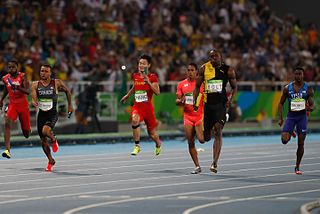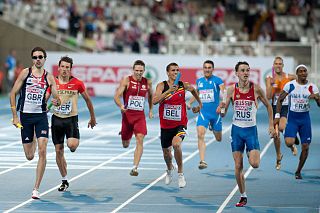
The England national football team have represented England in international football since the first international match in 1872. It is controlled by The Football Association (FA), the governing body for football in England, which is affiliated with UEFA and comes under the global jurisdiction of world football's governing body FIFA. England competes in the three major international tournament contested by European nations: the FIFA World Cup, the UEFA European Championship and the UEFA Nations League.

The English Football League Trophy, currently known as Bristol Street Motors Trophy for sponsorship reasons, is an annual English association football knockout competition open to all clubs in levels three and four of the English football pyramid, with the addition of 16 under-21 teams from Premier League and EFL Championship clubs since the 2016–17 season.

The Germany national football team represents Germany in men's international football and played its first match in 1908. The team is governed by the German Football Association, founded in 1900. Between 1949 and 1990, separate German national teams were recognised by FIFA due to Allied occupation and division: the DFB's team representing the Federal Republic of Germany, the Saarland team representing the Saar Protectorate (1950–1956) and the East Germany team representing the German Democratic Republic (1952–1990). The latter two were absorbed along with their records; the present team represents the reunified Federal Republic. The official name and code "Germany FR (FRG)" was shortened to "Germany (GER)" following reunification in 1990.

The 100 metres, or 100-meter dash, is a sprint race in track and field competitions. The shortest common outdoor running distance, the 100-meter (109.36 yd) dash is one of the most popular and prestigious events in the sport of athletics. It has been contested at the Summer Olympics since 1896 for men and since 1928 for women. The inaugural World Championships were in 1983.

The European Athletics Indoor Championships is a biennial indoor track and field competition for European athletes that is organised by the European Athletic Association. It was held for the first time in 1970, replacing the European Indoor Games, its predecessor event first held in 1966.

The 200 metres, or 200-meter dash, is a sprint running event. On an outdoor 400 metre racetrack, the race begins on the curve and ends on the home straight, so a combination of techniques is needed to successfully run the race. A slightly shorter race, called the stadion and run on a straight track, was the first recorded event at the ancient Olympic Games. The 200 m places more emphasis on speed endurance than shorter sprint distances as athletes predominantly rely on anaerobic energy system during the 200 m sprint. Similarly to other sprint distances, the 200 m begins from the starting blocks. When the sprinters adopt the 'set' position in the blocks they are able to adopt a more efficient starting posture and isometrically preload their muscles. This enables them to stride forwards more powerfully when the race begins and start faster.

The 4 × 100 metres relay or sprint relay is an athletics track event run in lanes over one lap of the track with four runners completing 100 metres each. The first runners must begin in the same stagger as for the individual 400 m race. Each runner carries a relay baton. Before 2018, the baton had to be passed within a 20 m changeover box, preceded by a 10-metre acceleration zone. With a rule change effective November 1, 2017, that zone was modified to include the acceleration zone as part of the passing zone, making the entire zone 30 metres in length. The outgoing runner cannot touch the baton until it has entered the zone, and the incoming runner cannot touch it after it has left the zone. The zone is usually marked in yellow, frequently using lines, triangles or chevrons. While the rule book specifies the exact positioning of the marks, the colours and style are only "recommended". While most legacy tracks will still have the older markings, the rule change still uses existing marks. Not all governing body jurisdictions have adopted the rule change.

The 4 × 400 metres relay or long relay is an athletics track event in which teams consist of four runners who each complete 400 metres or one lap. It is traditionally the final event of a track meet. At top class events, the first leg and the first bend of the second leg are run in lanes. Start lines are thus staggered over a greater distance than in an individual 400 metres race; the runners then typically move to the inside of the track. The slightly longer 4 × 440 yards relay, on an Imperial distance, was a formerly run British Commonwealth and American event, until metrication was completed in the 1970s.

60 metres hurdles is a distance in hurdling which is generally run in indoor competitions. It is equivalent with the first 5 hurdles of a standard outdoor hurdle race. The current women's and men's world records are 7.65 seconds and 7.27 seconds, respectively.

The 3000 metres or 3000-metre run is a track running event, also commonly known as the "3K" or "3K run", where 7.5 laps are run around an outdoor 400 m track, or 15 laps around a 200 m indoor track.
The European Junior Swimming Championships is an annual swimming competition for European swimmers organized by the Ligue Européenne de Natation and held over five days. The competitor age for females was 15 to 16 years; for males it is 17 to 18 years until 2015. From 2016 the competitor age is for females 14 to 17 years and for males 15 to 18 years.

The Algarve International Circuit, commonly referred to as Portimão Circuit, is a 4.653 km (2.891 mi) race circuit located in Portimão, Algarve region, Portugal. The development includes a karting track, off-road track, technology park, five-star hotel, sports complex and apartments.

The Diamond League is an annual series of elite track and field athletic competitions comprising fifteen of the best invitational athletics meetings. The series sits in the top tier of the World Athletics one-day meeting competitions.
The NACAC U18 Championships in Athletics is an bi-annual championships to athletes under-18 years of age in the year of competition held between the member associations of the North American, Central American and Caribbean Athletic Association (NACAC). The inaugural edition took place in 2019 in Queretaro, Mexico.










